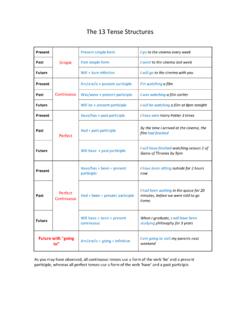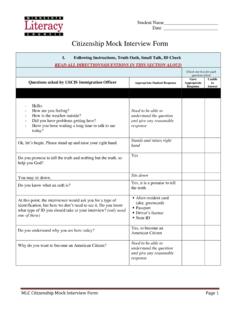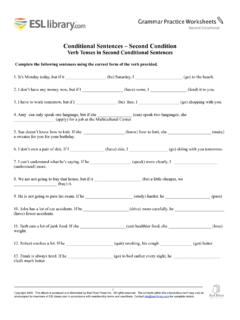Transcription of BIO181 LAB MANUAL - Estrella Mountain Community College
1 BIO181 LAB MANUAL Estrella Mountain Community College Spring 2011 BIO181 Lab MANUAL EMCC Spring 2011 Created by Smith/Steele Page 2 of 168 1/6/2011 BIO181 Lab MANUAL EMCC Spring 2011 Created by Smith/Steele Page 3 of 168 1/6/2011 Table of Contents Table of Contents .. 3 Safety Measures for Students In General Biology Classes .. 5 Metric System Conversions .. 9 How big is a ..? .. 18 Lab Equipment .. 22 Measuring Liquids .. 25 The Scientific Method .. 28 Week 1 Lab Report Instructions .. 33 GOOD GRAPH OR BAD GRAPH?? .. 38 Brain Warm Up: Molecular Modeling .. 44 Molecular Modeling .. 45 Functional Groups of Organic Molecules.
2 52 Solvent properties of oil, water, and alcohol .. 54 Brain Warm Up: Organic Macromolecules .. 56 Testing for Organic Compounds .. 57 Denaturation and Coagulation of Proteins .. 68 Measuring pH .. 70 LAB SUMMARY NOTES .. 71 Determining the Solute Concentration of Potato Cells .. 74 Osmosis Lab Report and 77 Cell Membranes and Osmosis Lab Stations .. 81 Brain Warm Up: Cells .. 83 Microscope and Cells Lab .. 84 Brain Warm Up: Calorimetry & thermodynamics .. 97 Food Calorimetry: Measuring the energy in Food .. 98 Brain Warm Up: Enzymes .. 109 Enzyme Lab Problem: Chemical Production .. 110 Enzyme Experiment Lab Report .. 126 How to use a Spec-20 .. 128 Photosynthesis and Cellular Respiration Review Lab .. 131 Brain Warm Up: DNA Structure .. 136 DNA and RNA Structure.
3 137 Brain Warm Up: DNA replication .. 144 DNA Replication - PUZZLE .. 145 DNA replication - COMPUTER .. 148 The Cell Cycle .. 150 Brain Warm Up: Gene Expression .. 152 Gene Expression Team 1 .. 154 Gene Expression Team 2 .. 156 Recovering the Romanovs .. 160 Brain Warm Up: Meiosis .. 162 Meiosis Reebops .. 163 Lab Final Study Guide .. 168 BIO181 Lab MANUAL EMCC Spring 2011 Created by Smith/Steele Page 4 of 168 1/6/2011 BIO181 Lab MANUAL EMCC Spring 2011 Created by Smith/Steele Page 5 of 168 1/6/2011 Safety Measures for Students In General Biology Classes CAUTIONARY STATEMENT In several of the laboratory exercises in Biology, you will use materials that are toxic, flammable, reactive, or corrosive.
4 Since exposure to any of these materials could pose a health risk, it is necessary that you understand and carry out basic lab safety procedures. If you are allergic to any of the chemicals used in specific labs, it is your responsibility to make note of it and consult with your instructor. If you are pregnant or have a compromised immune system (that is, you are on a chemotherapy regimen, you are taking corticosteroids, you have leukemia, AIDS, active tuberculosis, etc), the consequences of an exposure to certain chemicals are slightly greater than for individuals with a normal immune system. If you are pregnant, or if you have reason to suspect that your immune system is not fully functional, you should consult with your instructor and your physician for advice about taking Biology at this time.
5 LABORATORY SAFETY MEASURES Please follow the safety and preventative measures outlined below any time you are in the lab. If you do not follow these guidelines, your instructor may ask you to leave the lab. Wear proper eye protection (goggles or safety glasses that are ANSI approved) any time glassware or chemicals are used. Glasses without side shields are NOT sufficient. The bookstore has safety glasses which meet current safety standards. You should NOT wear contact lenses in lab. Wear gloves and safety goggles for any labs that involve animal dissection or hazardous chemicals. Be able to read and interpret the hazard labels on chemicals provided in lab. Be sure to read the hazard label before using each chemical. If you wish more information about chemicals used in lab, consult your instructor.
6 Follow explicitly directions given by the instructor for the use and disposal of chemicals used in the lab. NO FOOD OR DRINKS ARE PERMITTED IN THE LABORATORY. No smoking is permitted in the laboratory Tie back long hair and do not wear loose jewelry. You should not wear shorts or expensive clothes to lab. Open shoes, such as sandals should not be worn in lab. Keep open flames away from flammable materials and chemicals and YOU! Familiarize yourself with the location of the fire extinguisher and fire blanket in the room. Use equipment carefully. Ask your instructor for assistance if you have questions or problems. Report to the instructor any injury to yourself or another student, no matter how minor. Report to your instructor any spills so they can be cleaned up immediately.
7 BIO181 Lab MANUAL EMCC Spring 2011 Created by Smith/Steele Page 6 of 168 1/6/2011 BIO181 Lab MANUAL EMCC Spring 2011 Created by Smith/Steele Page 7 of 168 1/6/2011 This means it is easier to use! What s up with this? Why don t we use the metric system? BIO181 Lab MANUAL EMCC Spring 2011 Created by Smith/Steele Page 8 of 168 1/6/2011 MARS DISASTER: One Small Mis-step For NASA Can Lead To One Giant Step Forward For America (October 1999) The recent loss of the $125 million spent by NASA in developing the Mars Climate Orbiter might be the catalyst that wakes up Congress to realize that the cannot continue using two measurement systems.
8 This realization could be the beginning of the completion of metrication. U. S. Metric Association (USMA) president, Lorelle Young, blames the problem on a much larger issue, the failure of the to fully adopt the metric system. "This failure has much greater implications for the American public," she said. "There is no question that we will become a fully metric nation, but by foot-dragging the process we are depriving ourselves of the many benefits the American people could be enjoying now. By supplying the world with exports of metric goods we could greatly strengthen our economy and provide more jobs for American workers, and our math and science education-reform efforts would greatly accelerate if the metric system were taught consistently in our schools." NASA has been using the metric system for years according to JPL Administrator, Tom Gavin.
9 NASA mistakenly thought Lockheed, its contractor, was using metric data, but it turned out they were using inch-pound measures. Noel Hinners, vice president of flight systems for Lockheed Martin Astronautics in Denver admitted "We should have had them [the measurements] in metric units." NASA reported that the minimum survivable altitude would have been between 85 and 100 kilometers (53 to 62 miles). But the mismatch of measurement units allowed the spacecraft to come within 57 kilometers (35 miles) of Mars where the temperature was too high. NASA's plan was to approach the planet at 140 kilometers (87 miles). 2009 December 31 All products sold in Europe (with limited exceptions) will be required to have only SI-metric units on their labels. Dual labeling will not be permitted.
10 Implementation of the labeling directive, previously 1999 December 31, was extended by the EU Commission for 10 years, giving more time for companies to comply and for regulations to allow metric-only labeling on consumer products. BIO181 Lab MANUAL EMCC Spring 2011 Created by Smith/Steele Page 9 of 168 1/6/2011 Unit Conversions and the Metric System Converting between units of measurement is an important skill to learn. The most common systems of measurements are the English system and the metric system. While many people in the United States still use the English system of measurements, most scientists and many applications in healthcare use the metric system. If you grew up in the United States, you are probably most familiar with the English system of measurements.













